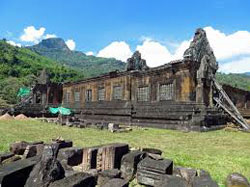Champasak has a population of about 670,122 including lowland Lao, Khmers and many unique ethnic minority groups. The province is also famous for the production of Lao coffee, tea, rattan and other agricultural produce. The bustling commercial center of Pakse is the capital town of Champassak. Founded as an administrative outpost by the French in 1905, Pakse retains much of its colonial legacy. The Champasak Historical Heritage Museum offers a good introduction to Lao culture, history and art. Perhaps the most famous building in Pakse is the Champasak Palace Hotel. From Pakse, you can drive to Paksong on Bolaven Plateau, home to ethnic minority communities like the Alak and Katu. Travelling from the Mekong to over 1000 metres in altitude, you pass through teak plantations, abandoned rubber plantations, durrian, peach, and pear orchards, robusta and arabica coffee plantations (some people say that Lao coffee is the best in the world), tea plantations, then Saravane where cattle are raised. On the plateau is the serene Tat Lo waterfall and resort, where visitors can enjoy unspoiled nature and elephant ride through the forest. Several water fall drop over the escarpment. One of the most spectacular is Tat Phan with height of 120 metres. Certainly the highlight of any visit to Champasak is the ancient Khmer temple of Wat Phu, located about 46 km south of Pakse along the Mekong River. Wat Phu is recognized as one of the most important Hindu sanctuaries of Cambodia’s Khmer Empire, which lasted from the 9th to 13rd centuries. Short History of Wat Phu Wat Phou is a famous place, worthy of being worshipped by the nation in the Lao People’s Democratic Republic. It is located at the foot of the holy mountain, call Phou Kao, immediately commands ones attention because of its shape, identified in ancient time with the linga, the phallic symbol of Shiva, from the originated its ancient name, Lingaparvata. The remains of which (large earthern enclosure walls, brick monuments) are barely visible on the ground, although they appear quite clearly on aerial pictures. Since 1991, excavation have been undertaken by P.R.A.L ( Project de Recherches en Arche ologie lao) with the aim of producing a precise archaeological map. According to the historians, Wat Phou is the oldest historical site of worship in the Lao People’s Democratic Republic, having been built over 1500 years ago. It used to be a center for Hinduism, for the worship of Shiva, the most powerful of the three gods, Praphom, Phashiva and Phavishanu. In the thirteen century, however, it became a Buddhist temple, and so it remains until the present time, becoming a place of great value both historically and culturally. It reminds us to keep in mind the considerable abilities of our ancestors, especially their creativity and patience, and so many people want to give worship with offerings and take pleasure in this beautiful ancient place. Around Wat Phou In the plain, about 1 Km south of the so called “ Nandin temple”, one can visit the remains of the small Nang Sida temple (Beginning C.XII ) and further on ( but of difficult access), the temple called ‘ Thao-Tao” (beginning C.XIII, jahavarman VII). Finally, on the othe side of the Mekong, on the bank of the ToMo river, are the remains of another temple (Oubmong) of the same period bit it also contains pre-Angkorian sculptures, particularly a beautiful Mukhalinga ( a human-headed linga). On the full moon of the third lunar month, which usually falls sometime in February, Champasak celebrates the traditional Wat Phu festival at the ruins. Festivities include elephant races, cockfights, and traditional performances of Lao music and dance. Another interesting island in this area is Done Khone and Khone waterfall as well as see rare freshwater dolphins (Pa kha in Lao).It’s best to go around 15:00-17:00 PM on a day with no wind during January- March, when they come upriver to spawn. They can’t pass the rapids, so you are quite likely to see them when they jump out of the water and it exited only one place in Asia. And Mekong Dophin Conservation Center is located on Done Khone Island. To visit the center visitors must go by road to Ban Veun kham, the last village on the Mekong before it flows in to Cambodia and then take a boat upriver 20 minutes to the center. There are guesthouses on Khone Island and good fishing in this area.
|

|